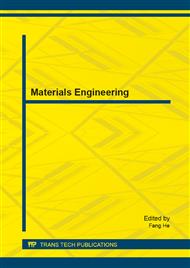p.39
p.45
p.49
p.57
p.63
p.69
p.75
p.81
p.87
Effects of Mono-And Dianhydrides on Thermal and Mechanical Properties Enhancement of Polybenzoxazine: A Property Comparison
Abstract:
Recent development of polybenzoxazines focuses primarily on broadening their thermal and mechanical properties such as their glass transition temperature, thermal degradation temperature as well as their flexibility and toughness. In this work, we have demonstrated that the incorporation of mono-or dianhydrides can improve both properties of polybenzoxazines but with different manner. Polybenzoxazine property enhancement by phthalic anhydride, PA, (monofunction) and pyromellitic dianhydride, PMDA, (bifunction) are systematically investigated and compared. It was observed that both mono-and dianhydrides can form covalent bonds through ester linkages with benzoxazine resin as confirmed by Fourier transform infrared spectroscopic technique. From thermogravimetric studies, degradation temperature of both anhydrides modified polybenzoxazines shows substantial improvement with increasing the amount of the anhydrides. Furthermore, char formation of the polybenzoxazine copolymers exhibits synergistic behavior with an addition of the dianhydride whereas that of monoanhydride-modified system shows a linear increase. On the other hand, it was found that tensile strength and elongation at break of monoanhydride modified polybenzoxazine are significantly greater than those of dianhydride-modified system comparing at the same mole fraction of the modifiers. However, tensile moduli of PA-and PMDA-modified polybenzoxazines are about the same and reveal an increasing trend with an addition of both types of anhydrides. The above results suggest effective methods to improve thermal properties of the polybenzoxazine with an incorporation of the dianhydride while better mechanical properties require monoanhydride as a polybenzoxazine modifier. The resulting copolymers can be used as high temperature matrix for carbon or glass fiber reinforced composite products.
Info:
Periodical:
Pages:
63-67
Citation:
Online since:
June 2014
Authors:
Price:
Сopyright:
© 2014 Trans Tech Publications Ltd. All Rights Reserved
Share:
Citation:


